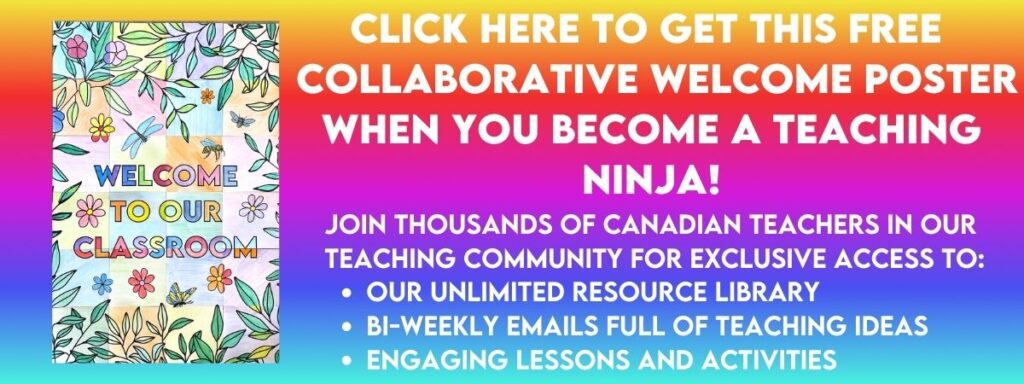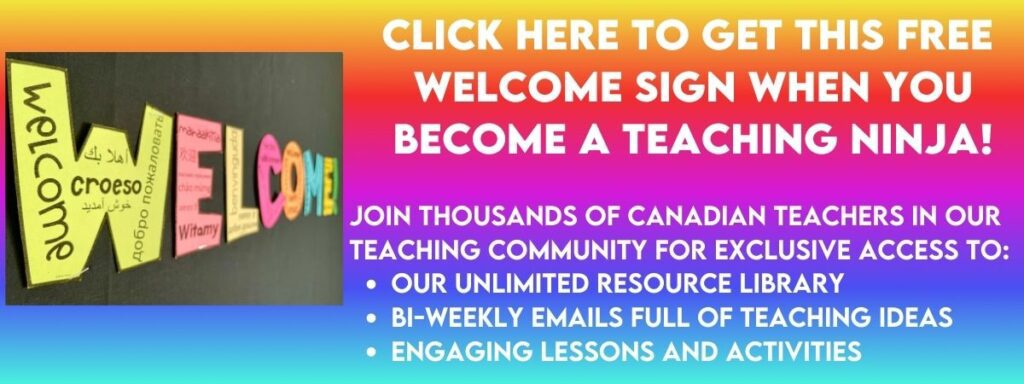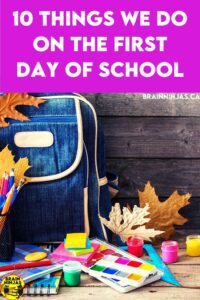
Be honest. You either LOVE the first day of school or hate it. As a teacher, it’s a fresh start to get back to spending quality time with these little darlings. For us, it’s always a chance to correct things we did in the past and start all over again, but there are ten things we do on the first day of school that help our whole year run smoothly. Turn back to school into a great time of year for you and your students. Keep on reading to find out how to make your first day back go smoothly.
Say Hello
Even if you already know some of your students because they are the siblings of past students, or if you’ve taught them in the past or if you are completely new to a school, starting the year off right matters. Depending on your school policies, your students might be wandering through the school looking for your classroom or will be lined up at a designated spot. Wherever they are, you need to be. Say hello. Introduce yourself. Ask about their names, their families, their summer and just chat to them like real people.
And, if the parents are there introduce yourself. Maybe use this time to let parents know where they can wait for their children at the end of the day. Our students are a little older, so most of the parents give them a little space and independence, but it’s better to let parents know your expectations at the very first opportunity.
Spend Some Time Getting to Know Each Other
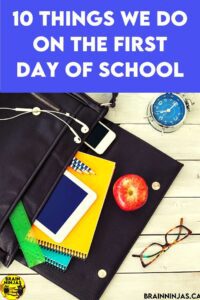
The temptation will be to run through a list of rules and expectations, put away all those school supplies or start to work right away, but don’t. Trust us. This took years to refine, but we have found that the first half-hour is best spent just talking and showing students who you are.
Allow your students to sit somewhere. Have them drop all those supplies and coats and anything else they have to one side and come to one area to sit together. We often sneak over to the school library (set it up with your librarian) because there’s a big seating area where we can sit in a circle together.
If you’ve ever had a community circle or class meeting, this is sort of like that. We choose a question we want everyone to answer. We use a talking stick or item. Only the person with the item can speak. We pass the item around the circle. Students can choose not to answer when it’s their turn, but we always come back to them later to see if they want to answer. Sometimes students are shy. Possible questions might be:
- What are you looking forward to this year?
- Do you have any goals for the year?
- What do you want to learn about this year?
- What are you worried about this year?
Do a bit of low-risk work
The temptation might be to do some writing or math so you can see what students can do/ Maybe reading, writing and math don’t need to be a priority on the first day.
Do you like to do logic puzzles? They require critical thinking, problem-solving, and deductive reasoning. And they are fun! Students learn to read for information in a way that is highly engaging.
Students are allowed to work together or try on their own. We look to see what students struggle with and how they respond to frustration. Which students work together and which ones like to work alone or can’t work with others? We look at how our new students try to work. You can learn so much about your students just by watching them.
The challenge with logic puzzles is to figure out what information you know for sure and what information you do not know and then compare it. The best part is that you rarely need any background knowledge to answer the puzzles because all the information is found right on the page. Students who love a challenge love logic puzzles because they aren’t easy, but they aren’t impossible.
Our students love to try to write them as well. We’ve created lots of different puzzlers in lots of different themes. You can find them all in our store. We’ve even made them digital (though we don’t recommend getting the devices out on day one).
Back to School Logic Puzzle Freebie in our TpT Store ($USD) or BN Shop ($CAN).
Back to School Logic Puzzles (with 20 puzzles) in our TpT Store ($USD) or BN Shop ($CAN).
Check out our different logic puzzles in our TpT Store ($USD) or BN Shop ($CAN).
Do you need some help learning how to solve logic puzzles? This is a video we often use to help our students understand and practice.
Get Organized

Our students bring their own supplies that they buy over the summer from a list. This means sometimes they bring weird things we don’t need (like glitter gel pens) and are missing things we need (like rulers with centimetres). We have our students sort out one item at a time. We go “slow” enough to get each item put away where it will live for the year.
First
- Have students bring all their supplies to one spot (at their desk or seating area).
- Set out bins/trays where items will be collected.
- Give each student their own bin or desk tray.
- Give each student a plastic zippered bag.
Second
- Binders: Write student names on the side with a marker (or use labels) and then place these on the shelf where they will live all year.
- Duotangs/Report Covers: Do not have students write their names on these. Just have students drop them into a bin/tray. Later as we start to set up subject areas we use these.
- Lined Paper/Blank Paper: Have students just drop these into a bin or tray. Later as we start to need paper, we use it from a community pile so that we don’t waste it all.
- Tissue: If your school collected tissue, put all these boxes in your cupboard or wherever you keep them. One year we kept ten boxes in the classroom and put the rest in our garage at home because there just wasn’t enough storage in the classroom. Do what works for you.
- Rulers: We collect these and keep them until they are needed. This way when we get to the measurement unit or need them for art, they haven’t already been destroyed through unnecessary sword fighting.
- Pencil Cases: We always ask for two. One is for colouring gear (like pencil crayons or markers) and the other is for writing utensils.
- Colouring Gear: Students put a set of markers or pencil crayons a pencil case-unless they choose to keep them in the box they come in. This gear goes in their desk tray or bin.
- Writing Gear: Have each student place 2 pencils, 1 pen, 1 highlighter, 1 eraser, 1 glue stick and their scissors in their other pencil case. Place this in their bin or desk tray.
- All Other Writing Tools: Place these in the zippered plastic bag and label it with each child’s name.
Third
- Coats/Outdoor Wear: Show students where this goes.
- Indoor Shoes: Show students where these live when they aren’t on feet.
- Lost & Found: Show students where they can place found items and look for their lost items.
Set Up Your Routines
Don’t make rules. Set up routines. Think about these things.
- Where should students line up? How do they come into class/school after a break, lunch or at the start of day?
- How do students leave the classroom? What route should they take out of the school?
- Where should student put different materials?
- Where do students hand in materials?
- How do students ask to go to the washroom?
- What expectations are there around food in the classroom, hats in the classroom, headphones in the classroom, smartphones or some of those things that may be school policies?
- What are your expectations about borrowing materials likes books, pencils or personal items?
Start a Read Aloud
Pick a great novel and start reading it on the first day. You can come back to it all through the day in between things since that first day of school is usually a little clunky getting used to the bell schedule and getting organized.
Start a Collaborative Art Project
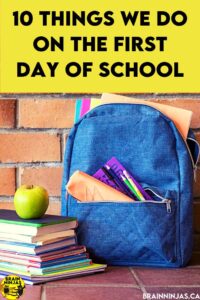
One of our favourite things to do on the first day is a graffiti wall. It’s so easy and everyone can participate. We get a long piece of paper (you know those big rolls of butcher block style paper) and run it along one wall. We’ve also done this on the floor in the hallway one year. Students bring their colouring gear. We talk briefly about what we want to draw as a class. Past themes have included: things that make us happy, our amazing school year (like a prediction), and everything we want to learn (someone included learning to fly). We always mention that we expect everyone to participate and we expect everyone to respect everyone else’s contribution (like we would never cross out or judge someone else’s work).
Another project is Back to School Power Words. We also have this entire post of Back to School Art Projects.
Even better, do a collaborative poster. It’s a calming activity that makes a great bulletin board. We have a few different ones available in our TpT Store and Brain Ninjas Shop.
We’ll send you a free copy when you sign up for our email list, which also gets you access to our free Resource Library. It’s already in the library if you’re a ninja. We also have a French version.
Sort Out Seating
If you plan on having a seating plan, get this organized. If you plan on having flexible seating, talk about your expectations. We always tell our students that seating can change anytime, so they need to be as responsible as they can if they want to stay where they are sitting.
Not sure about flexible seating? Check out our blog post called Everything You Need to Know About Flexible Seating. A checklist is included in that post to help you get started.
Do a Group Activity
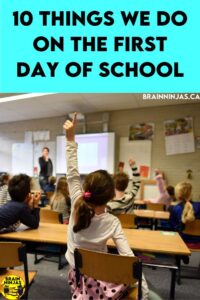
Some of our favourite activities to try on the first day include the whole class. We’ve tried drama circles for some years, but this can be stressful for some students on the very first day, so we’ve tried activities from our Group Activities Unit. This is a collection of group activities that encourage communication, cooperation and community.
Say Good-Bye
Go through end-of-day routines. We have our students tidy up our classroom every day. They learn pretty quickly that everyone chips in to tidy up by straightening desks, picking up things off the floor, tidying shelves and putting materials away. We learn that our classroom needs to be clean so the custodians just have to do the cleaning, not the picking up.
Hand out any forms or items students need to take home and remind them they need to be responsible to make sure they get home. Remind them you are counting on them to show parents important forms and then bring back signed forms.
On the way out the door, we say goodbye to each student. We offer them a choice of a handshake, high five or when they are ready a hug. They are also welcome to pass. If they’ve had a tough start to the school year, we make sure to let them know it’s a fresh start again tomorrow. Never let students go home thinking you are mad at them.
And now you’ve made it through another first day of school. Make notes of the things you’ll change for the next year. You’ll notice we don’t use any technology on the first day. Lessons have been learned to keep it all as simple as possible for the first day. Once you’ve met your students you have the rest of the year to learn!
Invite your students to your classroom by welcoming them in their native language. This free bulletin board is our gift to you for signing up to our email list or if you’re already a member, you can find it in our Resource Library.
This started a simple tradition to welcome our students and now we want to pass it along to you.
What Next?
If you are just getting your back to school planning done, we have several posts that might help you out with that:
- Your Must-Do Back to School Checklist.
- It’s Time to Get Your Emergency Sub Plans Ready
- Build Community With Theme Days for School
- Simple Art Projects for Back to School
What else do you include in your first day of school routines? Let us know in the comments below!

